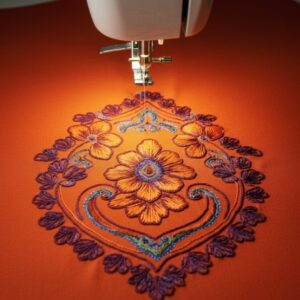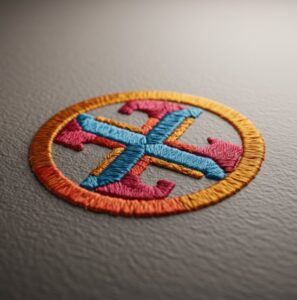
Auto Stitch vs. 100% Manual Embroidery: Understanding the Key Differences in Quality and Precision
Embroidery is an art that requires meticulous attention to detail, whether it’s creating logos, designs, or artwork on fabric. There are two main methods of embroidery used in the industry today: auto stitch embroidery and 100% manual embroidery. Each method has its own set of advantages and challenges, and the choice between the two can significantly impact the outcome of your design. In this article, we will explore the key differences between auto stitch and manual embroidery, focusing on quality, precision, cost-effectiveness, and the best use cases for each method.
What is Auto Stitch Embroidery?
Auto stitch embroidery refers to the use of embroidery machines that are controlled by software to automatically create designs. These machines can be pre-programmed with stitch types, patterns, and designs, allowing them to work quickly and with high efficiency.
The process involves converting a design file (such as an image or logo) into a series of commands that the machine can follow. The machine then automatically executes the design, making it a fast and highly reproducible method for producing embroidery. Most commercial embroidery businesses use auto stitch machines for high-volume production, as these machines can work continuously without the need for constant human intervention.
Advantages of Auto Stitch Embroidery:
Speed and Efficiency: Auto stitch machines can complete large embroidery jobs much faster than manual methods. This is particularly useful when working on bulk orders.
Consistency: Since the machine follows preset instructions, the results are highly consistent. Each design will have the same stitch quality, placement, and color distribution.
Cost-Effective for Bulk Orders: For businesses handling large quantities of embroidery, auto stitch embroidery is more cost-effective in terms of labor and time.
Less Skill Required: While there is still a need for an operator to monitor the machine, auto stitch embroidery requires less skill compared to 100% manual embroidery.
Auto Stitch vs. 100% Manual Embroidery
Auto Stitch vs. 100% Manual Embroidery
Comparing Auto Stitch vs. 100% Manual Embroidery
1. Quality of Work
When it comes to quality, the decision between auto stitch and manual embroidery often comes down to the level of intricacy required.
Auto Stitch Embroidery is suitable for standard designs and logos with a limited number of colors and stitches. It is incredibly consistent and efficient but may lack the ability to execute the fine details that manual embroidery can achieve. For example, designs with subtle shading or highly intricate patterns may not look as sharp when done on an auto stitch machine.
Manual Embroidery, however, shines when it comes to high-quality work that demands detail, depth, and texture. Since every stitch is crafted by hand, the final product can achieve intricate shading, precise thread placement, and a unique texture that machine embroidery can’t replicate. This is why manual embroidery is often preferred for high-end products, such as custom monograms, luxury fashion, and detailed art pieces.
2. Precision and Accuracy
Precision is critical for both methods, but each achieves it in different ways.
Auto Stitch Embroidery excels in precision due to the programmed software. The machine executes each stitch exactly as instructed, leading to uniform results across large batches. It is highly accurate in following designs but may fall short when it comes to capturing complex, nuanced details.
Manual Embroidery provides a higher level of accuracy in custom work, especially when fine details or artistic interpretation is necessary. Although human hands can be more prone to slight variations than machines, skilled artisans are capable of maintaining tight control over their stitches, often ensuring a higher level of personalization and artistry.
3. Turnaround Time
When it comes to turnaround time, auto stitch embroidery is the clear winner.
Auto Stitch Embroidery offers faster production rates, making it ideal for bulk orders and large-scale projects. Machines can run continuously, and once a design is digitized, it can be produced repeatedly with minimal delays. This makes it the best choice for businesses or individuals requiring large quantities of embroidery in a short amount of time.
Manual Embroidery, on the other hand, is far more time-consuming. Each piece takes hours or even days to complete, depending on the design’s complexity. As a result, manual embroidery is typically reserved for smaller orders, custom pieces, or high-end projects where speed is less of a priority.
4. Cost-Effectiveness
Cost is a significant factor in the decision-making process when choosing between auto stitch and manual embroidery.
Auto Stitch Embroidery is the more cost-effective choice for large, repetitive orders. Although the upfront cost of an embroidery machine can be high, it becomes more economical over time with large-volume production. Additionally, the labor costs are lower since the machine requires less intervention once it is set up.
Manual Embroidery involves higher labor costs, especially for intricate designs. Skilled artisans are required to stitch each piece by hand, which can make the cost per piece much higher compared to machine-stitched embroidery. However, the level of customization and the high-end nature of manual work often justifies the premium price for luxury items or one-of-a-kind designs.
5. Best Use Cases for Each Method
Auto Stitch Embroidery is best suited for:
- Large-volume orders, such as team uniforms or promotional merchandise.
- Simple, repetitive designs like logos, text, or basic patterns.
- Budget-conscious customers who need high-quality work at a lower price point.
Manual Embroidery is ideal for:
- High-end or luxury products, such as monogrammed items, bridal wear, or custom art.
- Intricate designs requiring fine details, shading, or textures.
- Small orders or one-off projects where personal craftsmanship is highly valued.
Here We Are At Your Service, 24/7 Live Support
Share this:
- Click to share on Twitter (Opens in new window)
- Click to share on LinkedIn (Opens in new window)
- Click to share on Tumblr (Opens in new window)
- Click to share on Facebook (Opens in new window)
- Click to share on Pinterest (Opens in new window)
- Click to share on WhatsApp (Opens in new window)
- Click to share on Reddit (Opens in new window)






